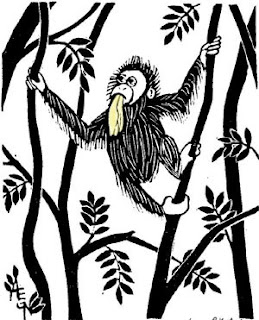Method 4. Print your single block in black, then color the print like a coloring book.
This seems to be a very popular method among children's book illustrators these days. Because each print is colored in individually, this wouldn't be a method particularly well suited to turning out an edition of hundreds of near-identical pieces, but of course with modern book-printing technology, you need to make only one original and then digitize it. However, this is also one of the earliest methods of making color illustrations in books. Often a book would be available with the option of black and white or color. If you bought the black and white version, you might color it in yourself. If you bought the color version, someone else would have painted over the black and white block prints for you - sometimes with real artistry, but often quite crudely.
Today's hand-colored block prints are anything but crude. I've seen a few artists who use colored pencil, but most use watercolor. I've used this method from time to time to highlight a detail of an otherwise uncolored block, as in the one tiny spot of green for the pea under the princess's stack of mattresses, or the single flash of red at the back of a downy woodpecker's head. When I do it I have to paint very carefully, most definitely staying between the lines, because the vast majority of my blocks are printed with water-based ink, and if I painted right over the black ink, it would smudge and run into my watercolors. Artists who use this technique more lavishly print with oil-based ink. Once oil-based ink is dry you can paint over it all you like.
So, there you have it: four basic methods for adding color to block prints whenever you're craving something bright. But as for me, having spent two weeks here going through all different ways to make colored block prints, I come to the end ready to go back to where I began: I love color - bright, beautiful, vibrant, rich, infinitely variable color - but when it comes to block prints, I really just want my black and white!
[Pictures: Ready for Planting, hand painted wood block print by Mary Azarian;
Klewasser (Clover), hand colored woodcut, c. 1500 (Image from Davidson Galleries);
Tom's Orangutan - Bukit Lawang, rubber block print with yellow watercolor by AEGN, 2004 (sold out).]




No comments:
Post a Comment
I love to hear from you, but please no spam, ads, hateful language, or other abuse of this community.